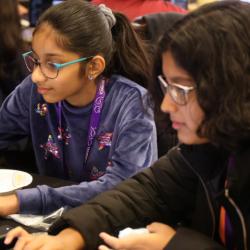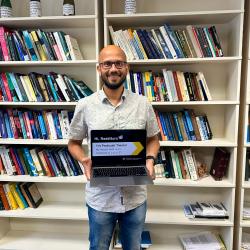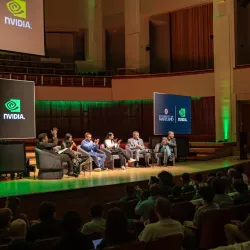Atmospheric and Oceanic Science Associate Professor Tim Canty Answers Questions About Climate Finance
The College of Computer, Mathematical, and Natural Sciences hosted a Reddit Ask-Me-Anything spotlighting climate finance expertise.

University of Maryland Atmospheric and Oceanic Science Associate Professor Tim Canty collaborated with Smith School of Business Professor-of-the-Practice Cliff Rossi on an Ask-Me-Anything (AMA) user-led discussion on Reddit to answer questions about climate finance on April 30, 2024.
Canty and Rossi partner closely on climate finance education at UMD, including teaching an executive education course on climate finance and risk management that is open to professionals in the finance and risk management industries.
An expanding part of Canty’s work on and off campus involves providing consultation and expertise to policymakers and risk management professionals to ensure the best available science is used to develop effective pollution control strategies.
This Reddit AMA has been edited for length and clarity.
Nuclear power (fission reactors): friend or foe?
(Canty) I'm a proponent of nuclear. If done right, it can be a cleaner source of electricity. However, there are significant engineering hurdles to ensure the safety of this energy source. When there's a problem with nuclear reactors, it's a major catastrophe. That said, more people have died over time from poor air quality due to coal-burning power plants.
Nuclear can help deal with the intermittency problem that many renewables face. For example, you can't produce solar energy when the sun's not out, or you can't use wind power when it's not windy. You could use nuclear power to fill the gaps.
(Rossi) Nuclear power has come a long way over the last 30 years in terms of its safety record. Given its cost-per-hour compared with other dirtier sources of energy, I would say we need to take a closer look at adding to our energy options and the opportunities associated with nuclear power.
What do you do with the captured carbon dioxide? Do you just store it for millions of years?
(Canty) You have to remember that the CO2 that we're putting in the atmosphere has been in the ground for millions of years. We just dug it up and put it in the air and the oceans. We need to figure out a way to put it back in the ground so that it won't leak out. New studies show that you can pump CO2 into recent volcanic flows after they've cooled sufficiently, turning the CO2 into basalt. That way it won't leak out and the CO2 is contained. They're doing this work in Iceland.
Are there any interesting programs in the works for the Eastern Shore of Maryland/Virginia?
(Rossi) There are many programs on the Eastern Shore of Maryland/Virginia. Cambridge, Maryland, has a combination of grants and loans provided at the state and local level to help remediate the fairly regular flooding happening downtown. There are also efforts to rebuild islands that sit off the Eastern Shore as barrier islands that have eroded significantly over the years. They're taking dredge material from the Inner Harbor to create a buffer from erosion in those coastal areas.
(Canty) We're building a new water-level sensor network for the Chesapeake Bay to understand whether it's sea-level rise or land subsidence, but more importantly, to understand how fast the water is rising and where it's going. We can't build an 11,000-mile sea wall for the Chesapeake Bay. But we can look into natural infrastructure like marshes that are cheaper to maintain than a concrete wall and can mitigate high tide events, storm surges, etc.
We are working with the Annapolis City Dock Project, where the city is spending about $90 million to make that area climate resilient with sea walls and raising some of the land. The U.S. Naval Academy is spending about $30 million or more on a sea wall. That's about $120 million for a few hundred yards of coastline. With the water level sensors, we're trying to help them understand what is called "nuisance flooding" or "sunny-day flooding" and how this is changing, whether these flood events will occur more frequently, and where the water is going.
Does it make financial sense to put solar panels over every parking lot in the southern half of the U.S.?
(Canty) It's a cost-benefit analysis—while I'm not sure how much it costs when you generate electricity, you also cool the surface down. So I think there's a benefit there that's not accounted for when you're shading the surface and cooling temperatures. You park beneath the solar panel, so the surface is shaded, which means it won't warm up as much, which could potentially cool down our cities. (This is called the urban heat island effect.) There's kind of a cascading effect of cooler cities, less money on air conditioning, etc.
How do we as a society change our behavior of not paying the true cost for the damage pollution causes—for instance, making oil and gas companies pay the true cost of exploration, extraction and transportation? We can't keep deferring the costs to future generations.
(Rossi) Unfortunately, I get what you're saying. However, as an economist, I believe that the price of these negative externalities (carbon emissions that cause climate change) should be reflected in the pricing of business services. But because that would raise the prices of consumer products, there would need to be some form of subsidy provided to lower- to moderate-income consumers.
(Canty) I think there is a responsibility all around. I'm a proponent of individual action—things like taking public transportation where it makes sense, shutting lights off when you leave the room like we did in the 70s, reducing food waste... Huge amounts of greenhouse gases are emitted by food production. Every time you throw food out, that is an unnecessary production and emission of greenhouse gases. For me, I don't like blaming other people (or corporations) if I am also to blame.
As someone who has to speak at graduations, we often say, "Your generation will have to solve these problems," which is a complete cop-out and abdication of responsibility. Every generation will just kick it down to the next generation, and we will not solve this in time if we do not take responsibility now.
Climate policy can face a lot of opposition even after enactment, for example here in Canada the federal government instituted a carbon tax which the political opposition is vehemently linking to inflation increases. How do you harden climate policies against partisan bickering/repeal once the governing party changes?
(Rossi) Policies should not be made from the extreme. The only way effective and long-term climate policy will get to where we want to be is if we have consensus and make prudent decisions balancing the long-term societal benefits of improving climate against the short-term goals associated with economic growth and productivity. The bottom line is that we need to be balanced in whatever policies we're coming up with so that we're not sacrificing today for the future. I agree with you that oftentimes we have too much whipsawing because we're on one extreme or the other.
What new scientific applications are enabled by the next generation of polarimeters (e.g., NASA PACE)? Particularly, which areas of aerosol science will benefit the most?
(Canty) PACE is going to give us unprecedented views of water color, which is an indication of biological activity that can help us map and understand harmful algal blooms. In terms of aerosols, understanding emissions, transport, and composition should all be improved. There's also a new NASA geostationary satellite called TEMPO, which is a game-changer for understanding air quality over the United States. You'll get hourly updates from the satellite at very high resolution and at times, as quickly as six-minute intervals with a spatial resolution of 200 meters.
Given we are roundly failing to get anywhere near the climate targets necessary to avoid catastrophic levels of warming, isn't there now a need for a much larger-scale focus on climate mitigation rather than just green energy and tech in general? And how does that change happen in a public policy environment where we know that warnings of doom turn people off rather than bring people along?
(Rossi) That's a great question. We absolutely need to be thinking as much about adaptation as we are about mitigation. I agree with the issue you raise, that scare tactics are not helpful. I think it is about elevating people's awareness that this is a real problem. Public service announcements should be less about scaring the public and more about informing the public.
(Canty) Cliff and I recently attended a meeting called "Going to Extremes," and Katharine Hayhoe (a great scientist and public speaker) pointed out that the increased awareness of the impacts of climate change has caused people to modify their behaviors and support legislation that has taken us off the worst-case climate scenario. So where once we were looking at 5 degrees of warming, now we are more on a 3.5-degree warming track—still not great, but moving us in the right direction.
How would you present the argument for climate action to people who may believe it will not be fiscally worthwhile?
(Canty) Last year in the U.S., we had a record number of billion-dollar weather-related events (not the wimpy half-billion-dollar kind), so I would argue that the risks are becoming more expensive. All of the data are pointing in the direction of things getting worse. So what is our risk tolerance? When is it too much, and will it be too costly if we wait too long? If we had taken action on this in the 1990s, we would have saved a lot of money in the long run (and maybe we wouldn't be having this AMA).
I'll point to the Montreal Protocol, which banned CFCs leading to the recovery of the ozone layer. The predictions at the time were that we would no longer have air conditioning or hair spray. This global agreement led to steps that are allowing the ozone layer to recover without destroying economies or lowering our standard of living.







